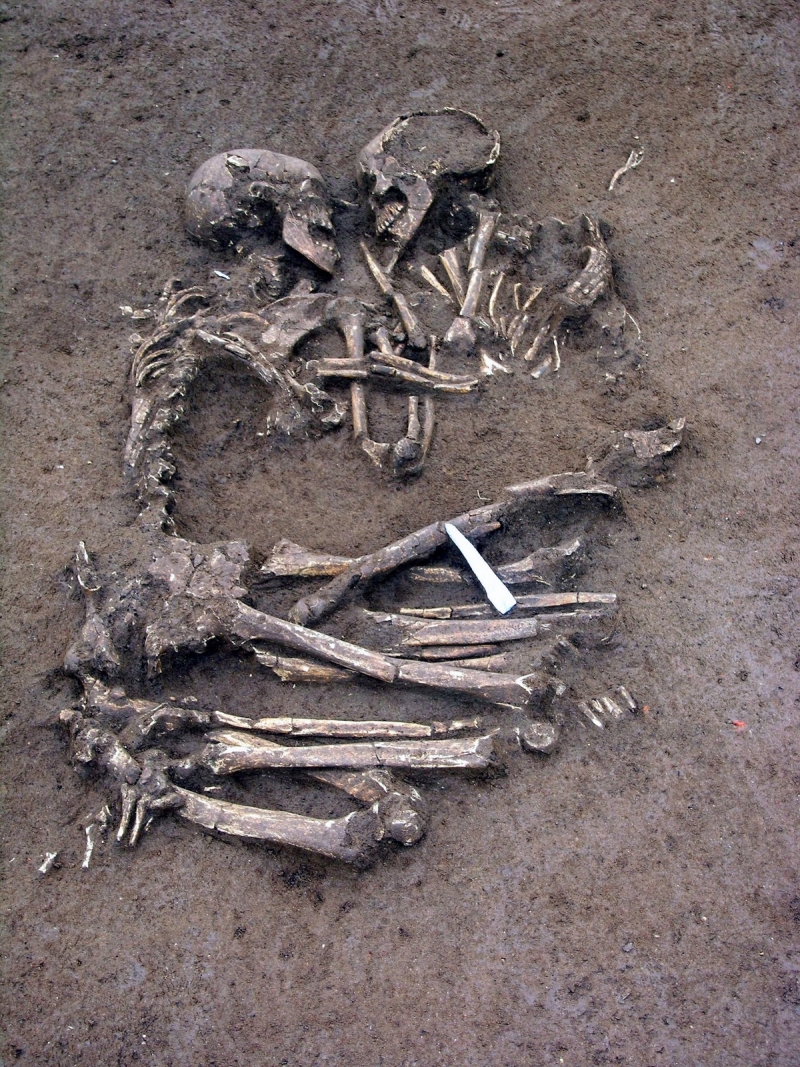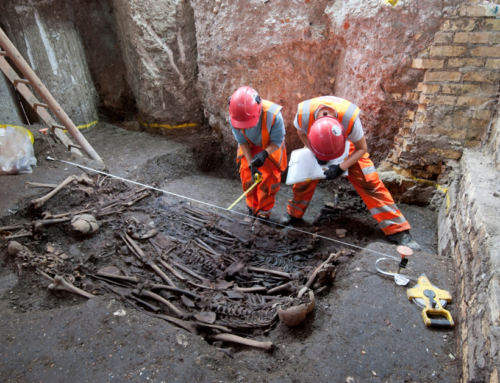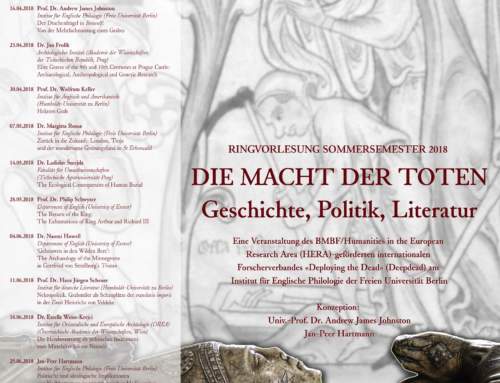In my first public presentation of DEEPDEAD research, I gave a paper at the British Shakespeare Association conference in Hull, UK (October 2016), on “Shakespearean Exhumations.” Here’s a snippet of the talk:
In February 2007, a team of Italian archaeologists led by Elena Menotti announced a remarkable discovery. Digging in a Neolithic necropolis in Valdaro, on the outskirts of Mantua, they had unearthed a pair of skeletons locked in an apparent embrace. The bones were described as belonging to a young man and woman, probably aged around twenty judging by the good condition of their teeth. Fragments of weapons including flint knives and a spearhead found associated with the bones hinted at a violent end, though subsequent analysis suggested this was not the case.
The image of the embracing skeletons instantly became and remains iconic, reproduced on t-shirts, pendants and earrings, and album covers. In Italy they became known as the Lovers of Valdaro. But internationally, they were immediately hailed as a Shakespearean couple. “Prehistoric Romeo and Juliet Discovered,” ran the headline in the Washington Post (7 February 2007); “Archaeologists find prehistoric Romeo and Juliet locked in eternal embrace” (USA Today, 27/02/07). According to Jason Urbanus in Archaeology magazine, “Archaeologists were suddenly quoting lines from Shakespeare’s Romeo and Juliet.” As the Daily Mail reported the story:
It is the city where the exiled Romeo dreamed he died and Juliet’s kisses breathed life back into his body. Tragically, the lifeless bodies of Shakespeare’s star-crossed lovers would soon lie side by side. Yesterday at Mantua, in an amazing echo of that heartrending story, archaeologists revealed the discovery of a couple locked in a tender embrace, one that has endured for more than 5,000 years.
In terms of historical fact, any linkage between Shakespeare’s Romeo and Juliet and the so-called Lovers of Valdaro is elusive to say the least. In the 1590s, Shakespeare described two lovers, who never really existed, being buried side by side. Five or six thousand years earlier, two people, who may or not have been lovers, were buried in what our eyes interpret as an embrace. It’s the location, Mantua, that turns this almost nothing into almost everything. Even so, it is difficult to see how the coincidence of location could amount to anything more than a mild irony. Yet the Daily Mail was perhaps onto something when it described the Neolithic skeletons as “an amazing echo of [Shakespeare’s] heartrending story.” Shakespeare may be several millennia more recent than the Valdaro Lovers, but he also precedes them.
The vision of doomed romantic love summed up in the reference to Romeo and Juliet has arguably had an impact on the archaeological interpretation of these human remains, as well as their public reception. As Pamela Geller has pointed out in The Bioarchaeology of Socio-Sexual Lives (2016), the sexes of the two skeletons had not been determined by forensic examination at the time the story broke – it was simply assumed. Subsequent analysis has suggested that the figure on the right is female, but the skeleton on the left is only “probably” male. This caveat has had very little impact on how the skeletons are presented, either in the media or in Mantua’s Archaeological Museum. Moreover, they were not necessarily alone together in the grave. Photos of the dig, which were much less widely publicized than the iconic image of the embracing lovers (and now seem impossible to find on the internet) show another skeleton lying just three feet away. Could that have been the Neolithic County Paris? There is also nothing to suggest that their relationship was “star-crossed,” or that the love they appear to testify to in death had been thwarted during life. The early assumption, now disproved, that one or both skeletons might have been killed by the flint weapons found with them in the grave, was clearly encouraged by the Romeo and Juliet paradigm.
Romeo and Juliet can tell us precisely nothing about Neolithic burial practices – but the response to the Valdaro skeletons tells us a great deal about what we desire from mortuary archaeology. In one of his short stories, Jorge Luis Borges describes a world in which envisioning a lost object is capable of bringing it into existence. Archaeology in “Tlön” unearths the products of the archaeologists’ imaginations. The recent vogue for discovering the remains of Shakespearean characters (not just the Neolithic Romeo and Juliet, but also Richard III) suggests that something similar is happening in our own world. Shakespeare’s plays may not be capable of actually planting bodies in the ground, but they are capable of shaping what we look for, and then telling us what we have found.





Get Social